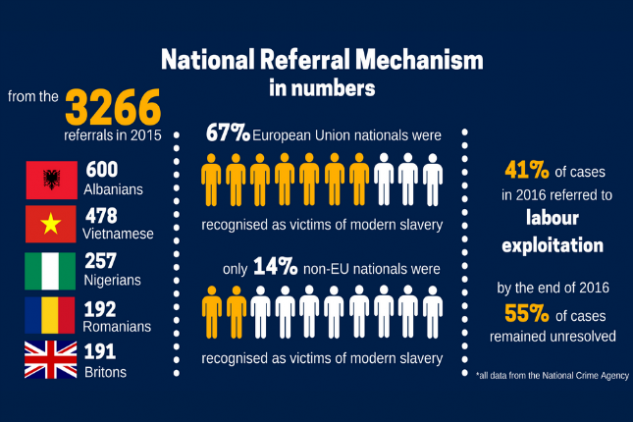
Identification of human trafficking victims: The UK approach in numbers
Victims of human trafficking have the right to support and protection. In the UK, the National Referral Mechanism (NRM) is the formal system for identifying and supporting victims.
Statistics showing the number of referrals by type of exploitation and variables such as nationality, are published regularly by the National Crime Agency. Earlier this year, FLEX highlighted that as many as 2052 potential victims, 55% of cases, referred to the NRM in 2016, were waiting for their cases to be resolved at the end of 2016. FLEX research has shown how long waiting periods act as a barrier to victims’ recovery and leave victims feeling insecure and disempowered.
The 2016 NRM statistics show a 17% increase from 2015 in the number of potential victims referred. Labour exploitation is the most common form of exploitation among potential victims, with 41% of NRM referrals. Potential victims of 108 different nationalities were referred in 2016, with Albanian, Vietnamese, Nigerian, Romanian and British nationals being the most prevalent.
There are, however, striking differences between nationalities in the number of people officially found to be victims of human trafficking (called ‘positive conclusive grounds decisions’); in 2015, 67% of potential EU victims were given victim status based on a positive conclusive grounds decision, compared to 14% of nationals of non-EU states. EU nationals were therefore almost five times more likely to be found to be victims than non-EU nationals.[1]
Referrals are currently handled by two different bodies depending on nationality: the National Crime Agency’s Modern Slavery and Human Trafficking Unit (MSHTU) is responsible for UK and EU nationals, while the cases of non-EU nationals are considered by the Home Office. While the MSHTU is a multi-agency organisation, the Home Office has immigration control at its core. Considering the significantly higher number of positive conclusions by the MSHTU, there have been criticism that the Home Office’s focus on immigration is a barrier to the recognition of victims. Following calls for a more holistic approach to identification, the 2014 Home Office review of the National Referral Mechanism recommended that all decisions, regardless of nationality, are made by a multi-disciplinary panel.
As a result of the 2014 NRM Review, changes to the NRM, including a multi-agency response, have been piloted in two regions of the UK, and the pilot review is due to be published shortly.[2] FLEX has previously called for a formal space for cooperation between actors in the field of detection and identification of victims. We welcome the forthcoming NRM pilot review and hope it will give insights that can assist the UK Government in rolling out a multi-disciplinary approach to the identification and support of victims of trafficking, regardless of nationality.
